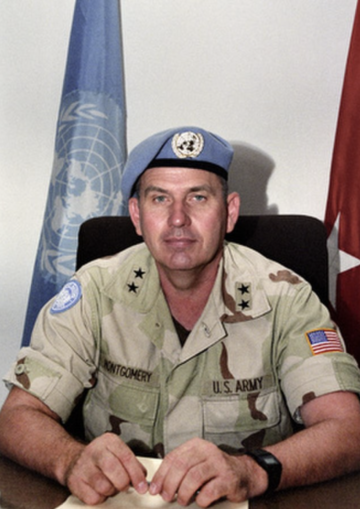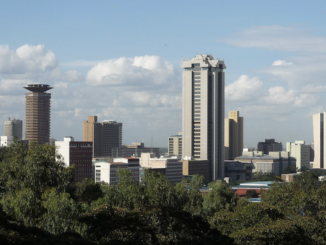Each morning in early 1993, UN Pakistan contingent troops answered the muezzin call to prayer. The purported common Islamic bond between Somalis and Pakistanis was considered by both sides to contribute to a special rapport in the initial weeks after the US pulled out handing over to the UN on 04 May 1993.
As part of UNOSOM II, Pakistani contingent was put in charge of Mogadishu. US Special Envoy had declared, “We have restored hope to this country.”
But Aidid had been watching the UN’s mandate change and was fully aware that he was soon to be disarmed and marginalised – forcefully. If Aidid, Ali Mahdi, Morgan etc. were disarmed under the US as originally planned, all would have accepted. The previous months had taught the warlords disarmament wasn’t likely to be carried out equally, and for Aidid as the most powerful warlord, dangerous.
A further source of Aidid’s ire was the work of April Glaspie, a US Foreign Service officer acting as the UN number two. She had won notoriety as the former ambassador to Iraq for reportedly nodding to Saddam Hussein on the eve of the 1990 invasion of Kuwait that the US were ambivalent about any such attack.
Glaspie went looking for work in Somalia after Madeleine Albright, the U.S. ambassador to the United Nations, refused to keep her on at the New York mission. Before that, Glaspie was forbidden by State Department officials to talk either to the press or to Congress about her ill-fated talks with Hussein, and was being made a scapegoat for the failed Mideast policies of the Bush administration.

April Glaspie shakes hands with Saddam Hussein,
Imad Marie – Public domain
In Somalia, UN documents and other credible sources note, she worked to marginalise Aidid and impose the NWO/UN will mandate.
On 4th June, Glaspie was one of a list of key military and diplomatic officials who gave the go-ahead for UN forces to inspect Aidid’s arms dumps and radio station “Radio Aidid”. Aidid was given about 14 hours’ warning, Glaspie believing he would not interpret the sudden inspection as an offensive act, yet would not have enough time to move his heavy weapons. The Radio Aidid broadcasts were irritating to Glaspie and US envoy Robert Gosende and both had received a request from Ali Mahdi for it to be destroyed.
When informed of the inspection by two UN officers, Aidid’s Interior Minister Abdi Hassan Awale “Qaybdiid” warned the move is unacceptable and would mean war. The Pakistani commander warned US Force Commander Gen Thomas Montgomery the operation would be highly politically sensitive and liable to an active response. Sure enough, the next day 24 Pakistani troops were killed by Aidid’s gunmen as the Pakistanis, as part of the UN force, were leaving an inspection. It was never established who fired the first shots.
In Somalia the use of force by UN peacekeepers would dictate daily rules of engagement – Chapter VII clause, which had recently been added. In part this was in marked contrast to Iraq where it was legitimized but did not control it. Compared with its lukewarm support for other UN operations the US had already made an expansive financial and political investment in Somalia and therefore insisted on seeding the entire mission with Americans.
The New World Order was to have a distinctly American flavour. UNSG Boutros Ghali had already appointed a Guinean as new envoy, already having the diplomat’s passport inscribed with his new position. However, the Clinton administration insisted an American hold the post. The unfortunate choice was retired Navy Admiral Jonathon Howe, a polite career man, born again Christian, described by the state Dept as, “The miscasting of the century.”

Admiral Jonathan T. Howe,
National Archives at College Park – Public domain
Howe had previously served as George Bush’s deputy national security adviser. The staff roster was loaded with US advisers, bureaucrats, and agents seconded from Depts State and Defence, the C.I.A. and other agencies. The prevailing deference was obvious including but not limited to the US appointing the deputy force commander.

Lieutenant General Thomas M. Montgomery,
Unknown military photographer of the Signal Corps – Public domain
That commander was Maj Gen Thomas Montgomery. He was in charge also of the 1,300-strong US Army Ranger Quick Reaction Force [QRF]. Meant and mandated as a backup for emergencies, Montgomery used it as his personal tool. Montgomery’s statement over conflicting roles and responsibilities was, as usual, ambivalent while inferring the preference of the use of the US QRF, “The message we are giving out is if we are tested, we are prepared for a decisive response.”
When that test came on 5th June 1993, the timing could not have been better for Aidid. Aidid supporters, now the famine had considerably eased, were easily manipulated to unrest when the UN was seen to be taking sides against their clan.
The UN Security Council [UNSC] met and a joint proposal by the Pakistani envoy and Madelaine Albright determined that Aidid was responsible for the earlier attacks and demanded his arrest. The UNSC eventually adopted Resolution 837. Citing chapter VII, UNOSOM II was authorised to take, “All necessary measures against those responsible for armed attacks.”
The preceding UNSC report found conflict had been inevitable since 4th June, the day before the Pakistani troop deaths, when the ultimatum-like search notice was delivered. In simple terms, it was the UN’s provocative actions towards the path of violence inevitable, not the killing of Pakistanis which was seen as a result of the UN moves.
Then the UNSC, with Albright’s guiding hand, hammered the final nail in Somalia’s coffin, “The clashes between UNOSOM II and the SNA thereafter were a direct result of the implementation of Resolution 837.” Ultimately it was that 5th June confrontation that touched off what then became a costly, unexpected and fruitless guerrilla war to hunt down Aidid.
An investigation Howe commissioned from Professor Tom Farer, Legal Advisor to UNOSOM II, pinned the blame for the 5th June fatalities firmly on Aidid, [the UN report link], but [under separate cover not to the UN] also cited Glaspie’s lack of impartiality in the balancing act of bringing rival clan leaders to the peace table.
When Farer’s report became fuel in Howe’s demonization of Aidid, Farer wrote an essay published in the Sept. 12 Washington Post that sounded an alarm over Glaspie’s “openly manifested sympathy” for one of Aidid’s most important political opponents, Mohamed Abshire, and her being, “Less than discreet about her hostility to Aidid,” and to Abdulahi Yusuf, Aidid’s most important ally outside his own clan. Farer declared, “The UN operation is headed for a rendezvous with disaster.”
Farer was not permitted to take testimony of five significant witnesses, one of them a top Aidid advisor. SRSG Howe could see no benefit in the proposition, and restricted Farer to the new fortress-like UNOSOM compound. The Somalia witnesses agreed to meet Farer in the compound provided they would be immune to arrest. Howe gave no such undertaking and the core evidence Farer sought never appeared.
A separate UN inquiry, although Aidid did not cooperate thinking it would not be neutral, later determined that the SNA had orchestrated the attacks, but they were spontaneous in response to the Pakistani shooting of one Somali and not premeditated or ordered by Aidid. The report determined the UN should pay compensation to civilians for damage caused in subsequent US-UN air attacks.
Aidid was in the US and parts of the UN, demonized as a “threat and menace” upsetting the delicate political balance and paving the way for months of conflict, the UN decided to deny Aidid a political future. The UN, not Somalis, were to oust him. The blood feud was on.
Within days, when the UN’s counterattack turned into an onslaught, SRSG Howe moved into a reinforced bunker beneath the US Embassy, which also doubled as the HQ for UN military. Howe began his New World Order “Nation Building” underground.
Outside the walls and beyond, preparations for the oncoming war was underway. The White House promised more combat helicopters, spectre gunships and other hardware.
As Somalis watched the preparations, they readied themselves, while Aidid continued to aggravate with radio broadcasts and ad hoc rallies irritating the US-UN further, asking the question all Somalis were asking, “Who are the UN going to fight with all these weapons and troops?”
© AW Kamau 2023



